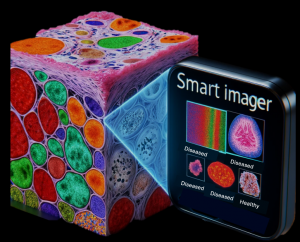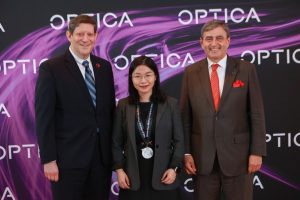Fei Xia wins Optica Foundation Challenge to develop smart microscope
Fei Xia, a postdoctoral researcher in the Complex Media Optics team led by Sylvain Gigan, has won a $100,000 grant from the Optica Foundation to explore new approaches for disease screening and treatment side-effect monitoring with the “smart microscope” that will facilitate non-invasive biopsies.
While they are the standard for disease diagnosis, conventional biopsies can be invasive and costly. Optical biopsy is a very promising alternative: it enables real-time, non-invasive visualization of tissue morphology and pathology. However, current optical biopsy techniques require contrast agents, expensive equipment, and skilled personnel.
Fei Xia’s project aims to combine the advantages of fluorescence microscopy by creating a digital spectral fluorescence imager. Fei Xia plans to combine the benefits of unlabeled (i.e., using naturally fluorescent biological objects) fluorescence microscopy and optical biopsy to address the shortcomings of current technologies.
“My research proposal is not conventional, as I incorporate more computational concepts into microscope development,” said Fei Xia. “For biopsies, diagnostic teams use a conventional microscope. This universal design is not enough; we need to tailor it to the problem. The rise of machine learning and advanced computational techniques creates new opportunities for the ‘smart microscope’ to better diagnose diseases.”
In practice, this means taking a hybrid approach called “computational imaging” or instead of simply working on analyzing images taken by a traditional microscope, integrating signal processing or artificial intelligence algorithms into the imaging system’s design and acquisition process, which allows for a simpler, cheaper, and faster optical system that better highlights potential pathologies. Fei Xia believes this technology is very promising and hopes to achieve a first demonstrator and optimize the concept within the next few months. Over the next 18 months, she will work to improve it for clinical and diagnostic applications.
“We are at the very beginning of this field of imaging: the intersection of optics, biotechnology, and information theory. It’s exciting. My goal is for the computational spectral fluorescence imager to offer a practical and cost-effective solution for improving diagnostic quality and driving progress in global health,” she summarized.
For more information, visit optica.org/foundationchallenge.


